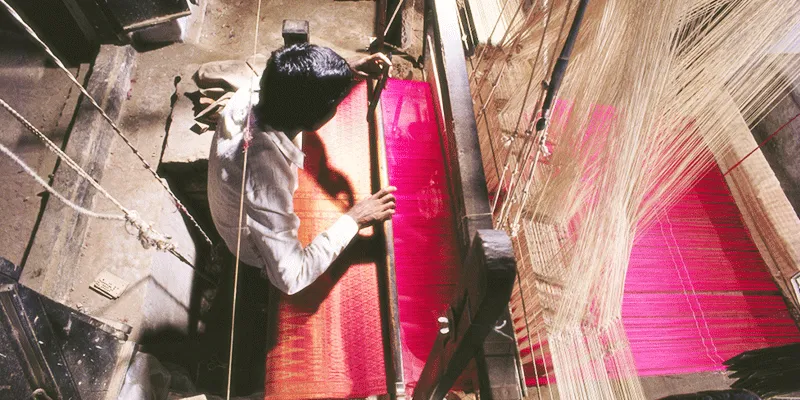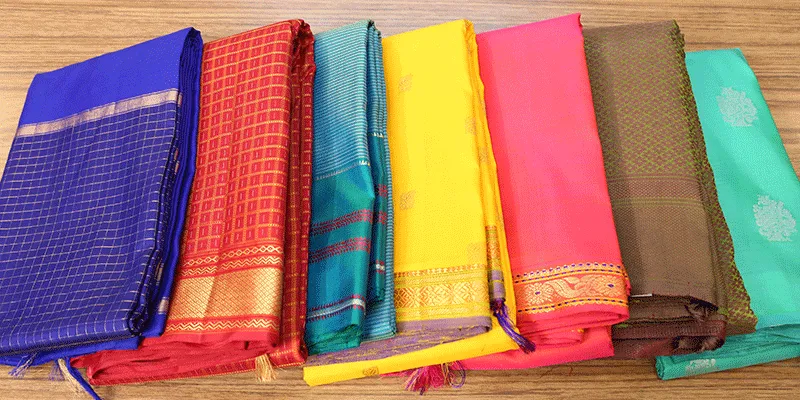How Pavithra Muddaya finds a finely woven story in every saree
A rich heritage of sarees, a clutch of gifted weavers, and an exclusive store with A-list clientele – it has been a long and successful entrepreneurship for Pavithra Muddaya in Bengaluru.
The beauty of a saree has no parallel and the craftsmanship that goes into making some of the finest ones is a heritage that we need to hold on to. It was with the aim of reviving heritage weaves and preserving the best talent in the country that Vimor Sarees was launched. Pavithra Muddaya, the Co-founder of the business, makes sure that her store offers creates unique pieces that have their own story to tell.
The story of Vimor

Pavithra Muddaya
Pavithra’s mother, Chimmi Nanjappa, the first manager of the Cauvery Arts and Crafts Emporium in Bengaluru, gained extensive knowledge of handicrafts and textiles over the years. In 1974, after her husband’s demise, she launched Vimor with her daughter.
“My mother and I registered the business under the name ‘Vimor’, which was also the name of our house,” Pavithra says. “We have never really advertised our store in Bengaluru but over time, many celebrities visited Vimor, and I am grateful.”

Immense effort goes into nurturing the weavers
The main aim in launching Vimor was to mentor weavers and give them a livelihood, along with a revival of heritage. Revival is a key factor in the making of the sarees, as it is important to embrace the past in order to find a place in the future. It becomes a matter of pride, for the weaver and the consumer.
“What makes Vimor special is the fact that we have formed a close-knit family with our weavers. Immense effort goes into nurturing their skill, independence, and growth. If I am not able to provide that kind of growth, I would rather see them flourish on their own,” Pavithra says.
The sensational saree

Vimor sarees are loved by collectors, celebrities and fashionistas
“Vimor is a 45-year-old business and we have functioned as a home store to date, without any advertisement or publicity,” says Pavithra. “I like to believe that purely goodwill has kept us alive.”
All their sarees are hand-woven and loved by both collectors and saree-enthusiasts.
“Now, I’m training the next generation of weavers who have taken up the business with modern education and launched enterprises of their own. They’ve opened their own stores with the skills they’ve learned,” she says.
While the sons diverge into their own businesses, the senior weavers stay back in order to be challenged artistically and aid the process of preserving their heritage. They encourage their sons to come back and learn about the aesthetics, design and features of the handloom saree, and they believe that it is important to remember where it all began.
Weavers, often considered “uneducated” possess skills that involve mathematical and technical precision. People need to understand the effort that goes into the creation of each saree.
“It’s easy for somebody to weave a saree, but setting the loom is the real challenge. The sheer variety that you can create with your hands is a real wonder,” Pavithra says.
Vimor’s clientele includes former presidents, prime ministers, celebrities, saree enthusiasts, and fashionistas, all united by their love for the hand-woven saree.
“Most women come down to our store to buy a couple of sarees but they stay back chat with us,” Pavithra says. “Everyone gives us a bit of their knowledge of what they remember of their grandmother’s sarees, and it becomes a very participative session.”
Why the saree will never go out fashion
Western trends are always in vogue but the saree will never go out of style. The one-shape-and size-fits-all outfit has been able to withstand the test of time and, even today, it is the only garment that can be elegantly wrapped around a woman to make her feel special and look magnificent.
“Our personalities are most beautiful in a saree and there are no two ways about it. The youngsters of today have different ways of wearing a saree now; sometimes they wear it with a tunic, a crop top, or even a pair of jeans, but it never fails to look good.”
According to Pavithra, women are exploring different ways to celebrate their ethnicity, but beyond ethnicity lies the comfort level of these sarees. She says that if you were to compare the kind of clothes we wear today, you will notice that nothing provides as much cross ventilation as the saree.
“The saree conceals as much as it reveals. You can feed your baby in privacy, you can rock your baby to sleep – it becomes very useful. Even after it is torn, you can convert it into a hammock for a baby. I believe that the saree is popular because of its utility value.”
The work that goes into a saree is a combined effort of the farmers and the weavers, and when we buy these sarees, it is an appreciation of their hard work.
Weekends are for creative pursuits
“Anything artistic easily piques my interest. I have an open mind and I’m able to absorb almost everything that is beautiful,” Pavithra says.
She enjoys watching cultural performances and everything that has a creative touch, and finds happiness in the smallest things.
Her passion for hand-woven sarees is long-standing, and she believes that her work will be carried forward into the future too. “I really appreciate today’s youngsters. They believe in a number of social causes, they’re willing to go forward, take risks, experiment and really make a change in the society. The future looks quite promising.”







